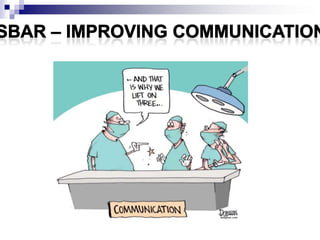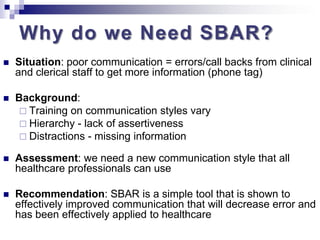SBAR
- 1. SBAR ŌĆō Improving Communication
- 2. Situation
- 3. Background
- 4. Assessment
- 5. Recommendation/ ResolutionWhat is SBAR?SBAR is a communication tool that provides a method of clearly communicating the pertinent information from a clinical encounterEmpowers all members of the healthcare team to provide their input into the patient situation including recommendationsAssessment and recommendation phases provide an opportunity for discussion among the members of the health care teamMay not be comfortable at first for either senders or receivers of information
- 6. Why do we Need SBAR?Situation: poor communication = errors/call backs from clinical and clerical staff to get more information (phone tag)Background:Training on communication styles varyHierarchy - lack of assertivenessDistractions - missing informationAssessment: we need a new communication style that all healthcare professionals can useRecommendation: SBAR is a simple tool that is shown to effectively improved communication that will decrease error and has been effectively applied to healthcare
- 7. How it will help us?Similar to the SOAP model Standardized approach that promotes efficient transfer of key information Helps create an environment that allows clerical and clinical staff express their concerns
- 8. What happens now:Multiple tasks created Multiple Quick Texts to pick from
- 11. Multiple calls from clinical staff to patients to get pertinent information
- 12. Multiple call backs from patients returning clinical staffŌĆÖs calls resulting in higher call volumesWhat will happen:1 TaskOnly SBAR communication tool usedMore information taken and provided to the clinical staffImportant parts of phone conversation included in exchangeFewer call backs to patients from Clinical staffFewer call backs from patients to Clinical staff
- 13. SBAR Guidelines: Step 1(S) Situation: What is the situation you are talking about?Identify self and patient name
- 14. What is going on with the patient that is a cause for concern. A concise statement of the problemSBAR Guidelines: Step 2(B) Background: What is the clinical background information that is pertinent to the situation?Diagnosis
- 15. List of current medications & allergies
- 16. Most recent vital signs
- 17. Lab results: provide the date and time test was done and results of previous tests for comparison
- 18. Medical history
- 19. Recent clinical findingsSBAR Guidelines: Step 3(A)Assessment: Share the results of your clinical assessmentWhat are the clinicianŌĆÖs findings?
- 20. What is the analysis and consideration of options?
- 21. Is this problem severe or life threatening?SBAR Guidelines: Step 4(R) Recommendation:What do you want to happen and by when? What action/recommendation is needed to correct the problem?
- 22. What solution can you offer the physician?
- 23. What do you need from the physician to improve the patientŌĆÖs condition?
- 24. In what time frame do you expect this action to take place?Example: Parent of a patient calls ŌĆ£Hi, I am calling in regards to my son, GeorgiePorgie, DOB: 1/12/05. He has had diarrhea for about 4 days now and when he woke up this morning he had a fever of about 101.2. I would like to speak to a nurse about this if they are available.ŌĆØ
- 25. Using SBAR in Quick Text S (Situation) ŌĆō Mom, Marge Porgie, would like to speak with a triage nurse. Pt has had diarrhea for 4 days and woke up this morning with a fever of 101. B (Background) ŌĆō Spoke with a nurse on 1/25 in regards to diarrhea.A (Assessment) ŌĆō Information sent to Triage for evaluation.R (Recommendation) ŌĆō Please call back mom at cell # 555-5555.
- 26. Dr. Levine would like to have Mary Contrary, who was seen for a physical today, to come back into the office in 2-3 months for a weight follow up. Please use SBAR to send a task to the Secretarial task list so that they can call this patient to set up the appointment.Nurses:
- 27. Secretaries: The mother of Elsie Marley calls with a request for labs that were done on 1/23/10. She is not at home but will have her cell phone with her, 555-0000.Please use SBAR to send a task to the support staff so that they can call the patient back.
- 28. Any Questions??















